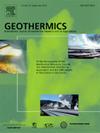Thermal shock resistance of lightweight cements developed for geothermal conditions
IF 3.5
2区 工程技术
Q3 ENERGY & FUELS
引用次数: 0
Abstract
Cements are a critical component in well construction, as they act to prevent well fluid and gas escape, prevent corrosion of the casing, and strengthen the wellbore to prevent deformation. Under the high temperature/pressure conditions common in geothermal systems, the injection of cold water for energy production is expected to induce cyclic damage to the borehole cement through the rapid temperature fluctuations. These “thermal shocks” are expected to cause casing shrinkage, annulus formation, and cement tensile stresses. To understand the effect of cold water injection on the wellbore environment, a set of rock-cement-steel samples were created to simulate the structure of a geothermal well. Lightweight thermally-insulating cement blends were tested under thermal shock conditions in this study. In each test, the samples were pressurized to an effective pressure of ∼3.5 MPa and placed at high temperatures. Thermal shocks were performed by injecting cold water (∼10-15 °C) through the samples at a constant rate while keeping the samples at high temperatures until the sample temperature stopped decreasing and deformation ceased. Eight thermal shock tests were conducted with each sample – two at 100 °C and six at 200 °C. Post-tests analysis was then conducted by cutting open each sample to examine the damage in each component of the simulated wellbore. Experimental results suggest that all samples experienced similar degrees of axial and lateral contraction during cold water injection, but for the most part this contraction is recoverable when injection halts. Post-test analysis revealed that fly ash cenosphere pre-treatment had the best effect on improving thermal shock resistance in the cement blends. Thermomechanical modeling of likely stress paths experienced by the cements during heating/cooling cycles shows that elasto-plastic cement constitutive behavior results in most plastic strain occurring during the initial heating steps, with mostly elastic strain occurring during the thermal shock cycles. This agrees with experimental evidence, suggesting that cement damage from shocking occurs via other mechanisms such as chemical alteration, corrosion, and fatigue.
地热条件下开发的轻质水泥抗热震性能
水泥是井施工中的关键组成部分,因为它们可以防止井中流体和气体逸出,防止套管腐蚀,并加强井眼以防止变形。在地热系统中常见的高温/高压条件下,注入冷水进行能源开采有望通过快速的温度波动引起井眼水泥的循环损伤。这些“热冲击”预计会导致套管收缩、环空形成和水泥张应力。为了了解冷水注入对井筒环境的影响,我们制作了一组岩石-水泥-钢样品来模拟地热井的结构。本研究对轻质保温水泥共混物进行了热冲击试验。在每次测试中,将样品加压至有效压力为~ 3.5 MPa并置于高温下。以恒定速率向样品注入冷水(~ 10-15°C),同时将样品保持在高温下,直到样品温度停止下降和变形停止。对每个样品进行了8次热冲击试验——两次在100°C下,6次在200°C下。然后,通过切割每个样品进行测试后分析,以检查模拟井眼的每个组成部分的损坏情况。实验结果表明,所有样品在冷水注入过程中都经历了相似程度的轴向和侧向收缩,但在大多数情况下,这种收缩在停止注入后是可以恢复的。试验后分析表明,粉煤灰空心球预处理对水泥共混物抗热震性能的改善效果最好。水泥在加热/冷却循环过程中可能经历的应力路径的热力学建模表明,弹塑性水泥的本构行为导致大多数塑性应变发生在初始加热步骤中,而大部分弹性应变发生在热冲击循环期间。这与实验证据一致,表明冲击对水泥的破坏是通过其他机制发生的,如化学变化、腐蚀和疲劳。
本文章由计算机程序翻译,如有差异,请以英文原文为准。
求助全文
约1分钟内获得全文
求助全文
来源期刊

Geothermics
工程技术-地球科学综合
CiteScore
7.70
自引率
15.40%
发文量
237
审稿时长
4.5 months
期刊介绍:
Geothermics is an international journal devoted to the research and development of geothermal energy. The International Board of Editors of Geothermics, which comprises specialists in the various aspects of geothermal resources, exploration and development, guarantees the balanced, comprehensive view of scientific and technological developments in this promising energy field.
It promulgates the state of the art and science of geothermal energy, its exploration and exploitation through a regular exchange of information from all parts of the world. The journal publishes articles dealing with the theory, exploration techniques and all aspects of the utilization of geothermal resources. Geothermics serves as the scientific house, or exchange medium, through which the growing community of geothermal specialists can provide and receive information.
 求助内容:
求助内容: 应助结果提醒方式:
应助结果提醒方式:


